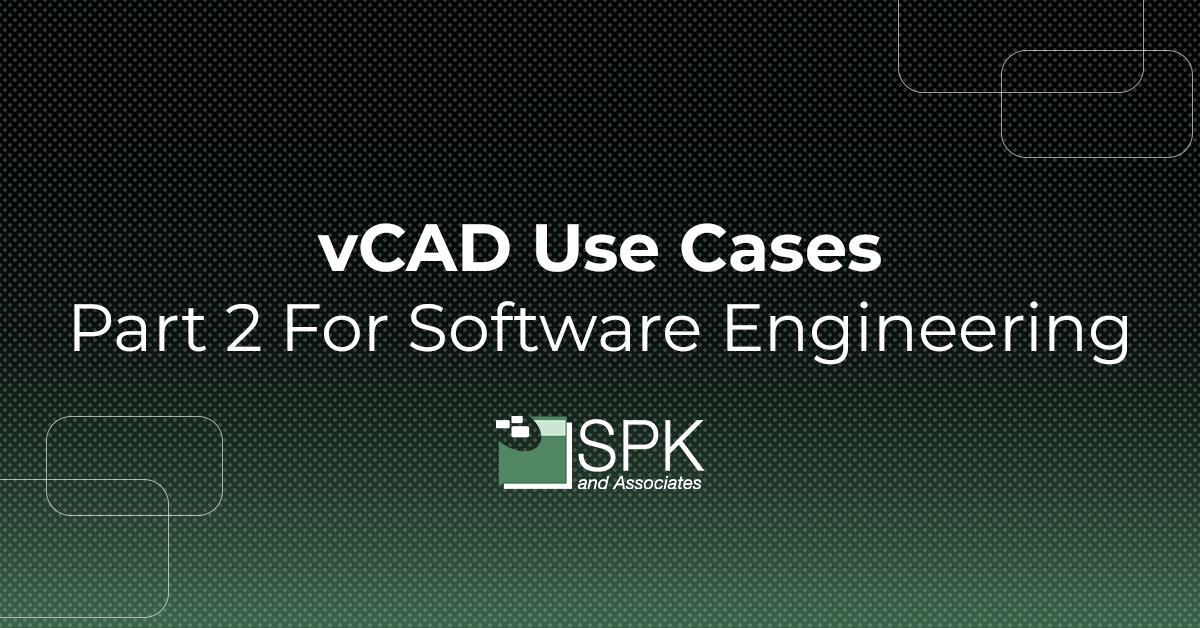Overview
Here is the VLOG transcript for Chris McHale, CEO of SPK, and Director of Engineering Ed Chung discussing virtual CAD (vCAD) use cases for software engineering..
Your hosts
Chris McHale – Co-founder and CEO of SPK and Associates
Ed Chung – Director of Engineering
Introduction To vCAD Use Cases For Software Engineering
Chris: Hi everybody, this is Chris McHale I’m CEO and co-founder of SPK and Associates. I’m here for another video blog discussion with Ed Chung.
Ed: I’m Edwin Chung, Director of Engineering at SPK. I make sure that the wheels keep turning.
Chris: Today, we’re going to continue the discussion of vCAD use cases for software engineering. We’ll give you a quick reminder in a minute about what vCAD is. This is part two of the series. Now, we’re going to talk about use cases for software engineers and the software engineering discipline.
Firstly, vCAD is a virtual engineering design development platform. Ed will talk a little more about it from a the software engineers perspective. In part one we talked about how it’s really useful for mechanical and CAD engineers.
You can watch or recap part one here
vCAD For Software Engineering: What Problems Can It Solve?
Chris: Now Ed, when customers come to us they usually have a particular set of problems or concerns they’re trying to address. vCAD can be a great answer. What are those typical problems and concerns?
Ed: Customers come to us with specific problems about how can I make on-boarding easier? How can I get things to be more efficient? How can I automate things correctly? I actually just got an email this morning about “how I automate things”! But, all these things lead to the biggest problem; having enough people. When people talk about efficiency, or things, it’s hard to keep staff and train new staff and to balance that with keep existing staff happy, present and loyal. So, I think a lot of it has to do with how do I make those people happy by removing the stuff they don’t want to do? How do I make them more productive?
vCAD Use Cases For Software Engineering
1. Morale and Productivity
Chris: So how does vCAD actually address morale and productivity for software engineers?
Ed: It’s been really exciting. There are multiple vCAD use cases for software engineer, For example, we run the computers in the cloud and they spin up and spin down. We empower these engineers to do it themselves and save cost. vCAD makes work convenient in software engineering. We’ve really seen a transition to vCAD. Originally we were deploying vCAD for SolidWorks users.
Ed: I believe our first use case was: SolidWorks users use these things that you can have a Nvidia powered workstation from whatever laptop, iPad and from wherever you are. It works great and they were excited to use it. Eventually, vCAD spread into software engineering groups. So one of our major customers is using this for software development and and I can give you some examples of specific things they’re doing with it. Alternatively, I can give you some broad examples and tell you about some of the advantages they’re seeing using vCAD.
Chris: Before you do that in 30 words or less, can you draw us a picture of what the vCAD platform is from the perspective of any engineer?
2. Reducing Cost
Ed: For this vCAD use case I need to describe it from two points of view.
- The engineer point of view is “I’m an engineer. I go to this application and hit this button. Then I get a pre-configured clean workstation that can run in my browser. It runs on any device and is ready for me to do my brilliant design work.”
- The second point of view is, I’ll call it a manager, or the bill payer. They say “We only pay for usage. When they turn vCAD on and design, it costs money. Then, when they turns vCAD off it doesn’t cost money.” So, it encourages people to not leave it on all the time.
Chris: Right. Because, we actually have timeouts that a user can set. I think these are pretty critical because most cloud providers don’t provide anything like that. But, we’ve actually built those in to help our clients save money and resources.
Ed: That’s right. And, every month managers come to me saying “how is this so cheap? Why haven’t we done it sooner.?”
3. Preconfigured Environments
Chris: Now, let’s shift to the vCAD use cases for software engineering specifically. Firstly, explain their particular needs and pain points or problems. Secondly, how does vCAD resolve those?
Ed: Two of their needs relate to generating a new computer. One is when you want to generate a new computer. Assuming you can get a new hardware and equipment, you need a certain environment. When I’m onboarding an employee, I budget the first day or two or our first week for multiple software installations. This includes attaining the correct version of software. Or, to get the correct libraries. These things take time. So, vCAD starts everything from a “template”. This template is a pre-configured image. Now, I’ve got consistency and ease for deployment. I hit a button and get a clean machine perfectly configured the way I left it. if I want two, four or eight of that machine I keep clicking the button. It always comes out the same. And, it doesn’t matter where I am. Another benefit is, if I’m working from home or vacation, I’ve always got that same consistent machine with the same performance.
4. Redeployment Of Valuable Resource
Chris: I remember years ago in one of our med device clients had a guy in one of their offices. It had lots of software engineers. And, they had one person whose key job was literally to set up development software, development clients, machines, for people with the exact checklist of whatever was needed. His job was to make sure that they had a consistent development experience. And, sorry to that guy but this completely eliminates his job.
Ed: Don’t be sorry to that guy because I remember him. He didn’t like it. How many times have you assigned your most junior software engineer to do that job but you both would rather have them writing code? This is a great vCAD use case for software engineering.
Chris: So true. What I would do is summarize that as saying vCAD provides clean, quick onboarding that’s scalable. Not just for new people, but even a new team. So, you have new people that you’re pulling on, or contractors, or you’re starting a new software development project. You say “here’s the template for that software development project everybody please go and get one of those.”
5. vCAD Use Case: Access Anywhere, Anytime
Ed: Another benefit is that vCAD lives in the cloud. I talked about “access anywhere”. This means anywhere. From a hotel, home and more. You can also pass it around and collaborate, You might want to show someone something and can say “here’s my laptop, right click this button. Now you’ve got it please do something on it, like fix xyz.” Or, please look this and then give it back to me.” With all the work from home, it’s nice to have another way to synchronously share a screen.
6. Improve Security With vCAD
Chris: On the mechanical CAD side we talked a little bit about protecting IP. Let’s explore similar but for vCAD uses for software engineering. How does this help and what are the benefits?
Ed: Essentially, there are huge security benefits. For example, protecting IPF from a security standpoint. Because the computer comes from a template, we can configure security and firewalls. And, we can configure it correctly to be secure. Now I know whenever I create from that template it’ll be secure. For my environment. From hackers. From incoming attacks. It’s block network access is also isolated. We generally take these VPNs, put them in the cloud or isolate them from our internal networks. Alternatively, we work our VPNs to get into our internal networks. Now, this way if it does become compromised, it becomes limited because these are assuming that IP is lost through external attacks.
Additionally, we’ve seen IP challenges with our mechanical people relying on contract manufacturers. Particularly, within other countries or far away. There’s IP theft from contractors and more. Instead of giving them access to your systems from their computer you give access using vCAD where we can control access. Within this vCAD use case, we can limit access and their ability to upload or download from other websites. Moreover, we can immediately cut access without asking them to send back a laptop or trusting them to delete things from their desktop. It’s me, the administrator log on with the management portal cut off access. I immediately take back this vCAD machine and can see exactly what’s on it. They don’t have access anymore. It’s a big deal
7. Accessing GPU Resources
Chris: The other day, you we were talking about when we originally deployed vCAD. You mentioned a lot of it the benefit was granting or having access to GPU resources within the cloud for mechanical CAD engineers. You were talking to me about how helpful that was in the software engineering world which was enlightening to me. Do you want to talk a little bit about that?
Ed: That’s one of the things that’s unique about our vCAD use cases. It has these GPUs like right NVIDIA, Tesla T4. Therefore, if you have a project that uses CUDA or KUDE, then those projects will translate work right in a presumably Ubuntu environment for example that’s running in vCAD.
8. Access And Test In Multiple Operating Systems
Chris: So then vCAD is available with really any operating system?
Ed: Yes. It’s been great for software developers running Mac OS. So, they’re running Mac OS, but they need a way to test an application on windows and Linux. Now, they have the ability to click a button and here’s a Windows pre-configured, ready to go machine. Stick your binary with no setting up updates, no drivers, no nothing. You can do your Windows apps inside of your mac OS. So yes, they’re definitely running different operating systems in there. Additionally, for the data science people, if you need CUDA and a GPU inside of your software project, you need it and it does change your available options significantly
Chris: Yes, because when I think about GPU, I tend to think about it more obviously for the mechanical CAD people. Then for the gamer and gaming software engineers an so on. But this is another need as well
Ed: Correct. Personally I have interest in artificial intelligence machine learning data science, and the industry. There’s big data sets, then doing data translation and migration, then waiting hours for it to process. If you are training a deep learning model on a large data set and it’s taking any amount of time, then there are two benefits. One is you need to run CUDA because that’s going to go 10, 100 a thousand times faster. Secondly if you run it on a a vCAD VM now your laptop can turn off.
Conclusion: vCAD Use Cases For Software Engineering
Chris: Is there anything else you want to add? Any other enlightening points or things that you think would be of interest to our audience?
Ed: I can go on and on. I think the real question is why not put it out there? If you’ve got one software engineer and the benefit of cloud is it’s on demand, you make this available on demand. If it saves them time then they can be more productive. And, if it doesn’t then they don’t have to use it. But, as an aside please give me some feedback because i’d love to add more features to make them productive, happy and awesome engineers
Chris: Thank you so much for your time Ed. I always enjoy our conversations
Ed: I’m happy to I look forward to the next time.
Chris: We’ll be doing another follow up in this series with vCAD use cases. I think we’re going to do mechanical simulation next because there’s some really great benefits there. Plus, there are good ways of using the tool. Take care and we’ll see you next time
Ed: Thanks Chris
You can watch or recap part one of this series “vCAD Use Cases For Mechanical Engineers” here
Want more tips and insights to accelerate your business?







